See Page 1 |
2 |
3 |
4 | of the March 2024 homepage archives. Thursday the 14th
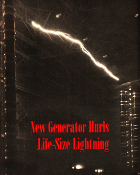 Nikola Tesla is usually credited with popularizing
experimentation with extremely high voltage. We've all seen the photos of his gigantic
generators discharging across a laboratory, including the iconic picture of Tesla
sitting calmly beneath an array of deadly bolts of artificial lightning, while looking
at a book. That was a heck of a reading lamp. These photos of a test laboratory
for lightning research appeared in a 1949 issue of Popular Science magazine.
Mr. Tesla would have loved it. Interestingly, Tesla's name is never mentioned
in the article. Maybe that's because it is a General Electric facility, a company
founded by Thomas Edison, who was a fierce competitor of Tesla back at the turn
of the last century. If this story had been about lightning research in a Westinghouse
lab, Tesla's name definitely would have been included. See "The War of the Currents."
Much has been learned about
nature of lightning and ways to mitigate the effects of it. The new battlefront
for high voltage tolerance is in electronics, where modern semiconductor devices
contain junctions that can barely withstand a dozen volts - never mind thousands.
That is the science of electrostatic discharge (ESD)... Nikola Tesla is usually credited with popularizing
experimentation with extremely high voltage. We've all seen the photos of his gigantic
generators discharging across a laboratory, including the iconic picture of Tesla
sitting calmly beneath an array of deadly bolts of artificial lightning, while looking
at a book. That was a heck of a reading lamp. These photos of a test laboratory
for lightning research appeared in a 1949 issue of Popular Science magazine.
Mr. Tesla would have loved it. Interestingly, Tesla's name is never mentioned
in the article. Maybe that's because it is a General Electric facility, a company
founded by Thomas Edison, who was a fierce competitor of Tesla back at the turn
of the last century. If this story had been about lightning research in a Westinghouse
lab, Tesla's name definitely would have been included. See "The War of the Currents."
Much has been learned about
nature of lightning and ways to mitigate the effects of it. The new battlefront
for high voltage tolerance is in electronics, where modern semiconductor devices
contain junctions that can barely withstand a dozen volts - never mind thousands.
That is the science of electrostatic discharge (ESD)...
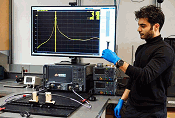 "In a first-of-its-kind development, UBC
Okanagan researchers, in collaboration with Drexel University, have created a new
compound that can be used to
3D
print telecommunication antennas and other connectivity devices. These 3D printed
products, created by combining a two-dimensional compound called MXenes with a polymer,
can be used as an alternative for metallic counterparts and can make a vast improvement
in communication technology including elements such as antennas, waveguides and
filters. Waveguides are everywhere, yet most people don't know what they are, says
Dr. Mohammad Zarifi, a researcher in UBC Okanagan's Microelectronics and Gigahertz
Applications (OMEGA) Lab. Waveguides are structures or pipes that help direct sound
and optical waves in communication devices and consumer appliances like microwaves.
Waveguides vary in size, but historically they are made of metal due to their conductive
attributes. Dr. Zarifi and his OMEGA team develop state-of-the-art communication
components that have a compatible performance to metal, but are 10 to 20 times lighter,
less expensive and easy to build..." "In a first-of-its-kind development, UBC
Okanagan researchers, in collaboration with Drexel University, have created a new
compound that can be used to
3D
print telecommunication antennas and other connectivity devices. These 3D printed
products, created by combining a two-dimensional compound called MXenes with a polymer,
can be used as an alternative for metallic counterparts and can make a vast improvement
in communication technology including elements such as antennas, waveguides and
filters. Waveguides are everywhere, yet most people don't know what they are, says
Dr. Mohammad Zarifi, a researcher in UBC Okanagan's Microelectronics and Gigahertz
Applications (OMEGA) Lab. Waveguides are structures or pipes that help direct sound
and optical waves in communication devices and consumer appliances like microwaves.
Waveguides vary in size, but historically they are made of metal due to their conductive
attributes. Dr. Zarifi and his OMEGA team develop state-of-the-art communication
components that have a compatible performance to metal, but are 10 to 20 times lighter,
less expensive and easy to build..."
 It is well known that American automobile
manufacturers really dropped the quality ball in the mid-1970s through about 1990.
Foreign car makers were gaining increased access to domestic markets with designs
that had more efficient engines and transmissions with superior materials and techniques,
and corrosion control was much better than most American cars that often began to
exhibit rust bubbles underneath the paint within a year or two - particularly in
regions where roadways were salted for controlling ice and snow. People (like me)
who bought used cars were leery about a vehicle with more than 70k-80k miles on
them because it was almost guaranteed that a major engine or transmission repair
would not be far off. Foreign cars, in contrast, were still going strong at 100k
miles. If you were there, you know of what I speak. I mention that background to
help explain the opening statement in this 1972 Popular Electronics magazine
article describing what could be expected in the near future with
electronics in cars and trucks. A look at the one drawing reveals that by now
everything predicted is now standard equipment even on low-end cars, and of course
not many people would have predicted GPS navigation, Bluetooth-connected tire air
pressure sensors, satellite radio, or even air bags... It is well known that American automobile
manufacturers really dropped the quality ball in the mid-1970s through about 1990.
Foreign car makers were gaining increased access to domestic markets with designs
that had more efficient engines and transmissions with superior materials and techniques,
and corrosion control was much better than most American cars that often began to
exhibit rust bubbles underneath the paint within a year or two - particularly in
regions where roadways were salted for controlling ice and snow. People (like me)
who bought used cars were leery about a vehicle with more than 70k-80k miles on
them because it was almost guaranteed that a major engine or transmission repair
would not be far off. Foreign cars, in contrast, were still going strong at 100k
miles. If you were there, you know of what I speak. I mention that background to
help explain the opening statement in this 1972 Popular Electronics magazine
article describing what could be expected in the near future with
electronics in cars and trucks. A look at the one drawing reveals that by now
everything predicted is now standard equipment even on low-end cars, and of course
not many people would have predicted GPS navigation, Bluetooth-connected tire air
pressure sensors, satellite radio, or even air bags...
 Model WM2PD-0.5-6-N from Werbel Microwave
is a
2-way power splitter covering the continuous bandwidth of 500 MHz to 6 GHz.
The product features low insertion loss, high isolation and excellent VSWR performance.
Tight phase matching and amplitude balance between outputs. Aluminum body with stainless
steel N female connectors. Ready for 5G and 6G deployment. The device is RoHS compliant.
Typical phase balance of 2 degrees and insertion loss of 0.8 dB... Model WM2PD-0.5-6-N from Werbel Microwave
is a
2-way power splitter covering the continuous bandwidth of 500 MHz to 6 GHz.
The product features low insertion loss, high isolation and excellent VSWR performance.
Tight phase matching and amplitude balance between outputs. Aluminum body with stainless
steel N female connectors. Ready for 5G and 6G deployment. The device is RoHS compliant.
Typical phase balance of 2 degrees and insertion loss of 0.8 dB...
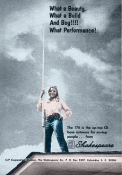 Uh-oh, here we go again. This is yet another
advertisement from a vintage electronics magazine that would never make it past
the politically-correct editors of today's cowardly corporations. This one appeared
in a 1970 issue of Popular Electronics magazine. We live in a time of hypersensitive
weaklings who benefit from an army of lawyers standing ready to come to the aid
of anyone who is the least bit offended. The same people who tell the rest of us
that we must not just tolerate, but accept and endorse their idiosyncrasies, are
the first to cry foul when faced with something that insults their sensibilities
(a lot are just compulsive agitators). My guess is that
Shakespeare's antenna sales were boosted by the ad, like it or not... Uh-oh, here we go again. This is yet another
advertisement from a vintage electronics magazine that would never make it past
the politically-correct editors of today's cowardly corporations. This one appeared
in a 1970 issue of Popular Electronics magazine. We live in a time of hypersensitive
weaklings who benefit from an army of lawyers standing ready to come to the aid
of anyone who is the least bit offended. The same people who tell the rest of us
that we must not just tolerate, but accept and endorse their idiosyncrasies, are
the first to cry foul when faced with something that insults their sensibilities
(a lot are just compulsive agitators). My guess is that
Shakespeare's antenna sales were boosted by the ad, like it or not...
 Banner Ads are rotated in all locations
on the page! RF Cafe typically receives 8,000-15,000 visits each
weekday. RF Cafe
is a favorite of engineers, technicians, hobbyists, and students all over the world.
With more than 17,000 pages in the Google search index, RF Cafe returns in
favorable positions on many types of key searches, both for text and images.
Your Banner Ads are displayed on average 280,000 times per year! New content
is added on a daily basis, which keeps the major search engines interested enough
to spider it multiple times each day. Items added on the homepage often can be found
in a Google search within a few hours of being posted. If you need your company
news to be seen, RF Cafe is the place to be... Banner Ads are rotated in all locations
on the page! RF Cafe typically receives 8,000-15,000 visits each
weekday. RF Cafe
is a favorite of engineers, technicians, hobbyists, and students all over the world.
With more than 17,000 pages in the Google search index, RF Cafe returns in
favorable positions on many types of key searches, both for text and images.
Your Banner Ads are displayed on average 280,000 times per year! New content
is added on a daily basis, which keeps the major search engines interested enough
to spider it multiple times each day. Items added on the homepage often can be found
in a Google search within a few hours of being posted. If you need your company
news to be seen, RF Cafe is the place to be...
Wednesday the 13th
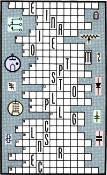 These
R-E Puzzlers look like a typical crossword puzzle, but they are not. The only
"crossword" aspect is a single letter being shared by two words. There are no words
formed vertically, only horizontally. That makes them a little more difficult because
if you don't know one of the words, there is no way to discover any additional letters
in it other than the one given. This particular R-E Puzzler appeared in a 1967 issue
of Radio-Electronics (hence the R-E part), so it is no surprise that there are a
couple vacuum tube related words. It should present no problem if you know common
numerical prefixes and append "ode" to the end. Have fun... These
R-E Puzzlers look like a typical crossword puzzle, but they are not. The only
"crossword" aspect is a single letter being shared by two words. There are no words
formed vertically, only horizontally. That makes them a little more difficult because
if you don't know one of the words, there is no way to discover any additional letters
in it other than the one given. This particular R-E Puzzler appeared in a 1967 issue
of Radio-Electronics (hence the R-E part), so it is no surprise that there are a
couple vacuum tube related words. It should present no problem if you know common
numerical prefixes and append "ode" to the end. Have fun...
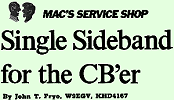 If you need a little brushing up on your
basic
single sideband (SSB) operational theory versus straight amplitude modulation
(AM), then let this dissertation by Mac to Barney be it. The piece was the topic
of "Mac's Service Shop" feature in the June 1972 issue of Popular Electronics magazine.
There are no circuit details, just talk about how power from the carrier and dual
sidebands is reallocated to a single sideband, thereby improving efficiency. I like
the 'dried milk' analogy Mac uses in reference to SSB being transmitted sans carrier
(i.e., water), with the receiver being responsible for reintroducing the carrier
in order to demodulate the signal. Although I cannot personally comment as to its
validity, many people familiar with comparing DSB AM to SSB AM say there is a certain
je ne sais quoi that is missing in the tonal quality of SSB... If you need a little brushing up on your
basic
single sideband (SSB) operational theory versus straight amplitude modulation
(AM), then let this dissertation by Mac to Barney be it. The piece was the topic
of "Mac's Service Shop" feature in the June 1972 issue of Popular Electronics magazine.
There are no circuit details, just talk about how power from the carrier and dual
sidebands is reallocated to a single sideband, thereby improving efficiency. I like
the 'dried milk' analogy Mac uses in reference to SSB being transmitted sans carrier
(i.e., water), with the receiver being responsible for reintroducing the carrier
in order to demodulate the signal. Although I cannot personally comment as to its
validity, many people familiar with comparing DSB AM to SSB AM say there is a certain
je ne sais quoi that is missing in the tonal quality of SSB...
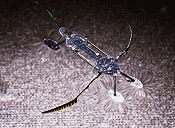 "Two insect-like robots, a mini-bug and
a water strider, developed at Washington State University, are the smallest, lightest
and fastest fully functional
micro-robots ever known to be created. Such miniature robots could someday be
used for work in areas such as artificial pollination, search and rescue, environmental
monitoring, micro-fabrication, or robotic-assisted surgery. Reporting on their work
in the proceedings of the IEEE Robotics and Automation Society's International Conference
on Intelligent Robots and Systems, the mini-bug weighs in at eight milligrams while
the water strider weighs 55 milligrams. Both can move at about six millimeters a
second. 'That is fast compared to other micro-robots at this scale although it still
lags behind their biological relatives,' said Conor Trygstad, a PhD student in the
School of Mechanical and Materials Engineering and lead author on the work. An ant
typically weighs up to five milligrams and can move at almost a meter per second..." "Two insect-like robots, a mini-bug and
a water strider, developed at Washington State University, are the smallest, lightest
and fastest fully functional
micro-robots ever known to be created. Such miniature robots could someday be
used for work in areas such as artificial pollination, search and rescue, environmental
monitoring, micro-fabrication, or robotic-assisted surgery. Reporting on their work
in the proceedings of the IEEE Robotics and Automation Society's International Conference
on Intelligent Robots and Systems, the mini-bug weighs in at eight milligrams while
the water strider weighs 55 milligrams. Both can move at about six millimeters a
second. 'That is fast compared to other micro-robots at this scale although it still
lags behind their biological relatives,' said Conor Trygstad, a PhD student in the
School of Mechanical and Materials Engineering and lead author on the work. An ant
typically weighs up to five milligrams and can move at almost a meter per second..."
 Unlike Radio Broadcast Data System (RBDS)
which is responsible for your FM radio being able to display song title and station
identification via a digital subchannel (began in 1992),
Subsidiary Communications Authorization (SCA) has been around as an analog subchannel
for more than half a century. SCA (was) used for tasks such as book reading for
the blind, telemetry, paging services, and most familiarly - Muzak (aka "elevator
music"). This article presents a simple circuit for stripping the subcarrier off
of the FM broadcast signal to permit a listener to avoid commercials, PSAs, weather
reports, and other items that are played between songs. Personally, I'll endure
the commercials and weather reports but would like to be able to block songs I can't
stand. Note the 6.3 VAC supply requirement, which is obviously a remnant from
the readily available vacuum tube heater voltage transformers that were on their
way out of common use... Unlike Radio Broadcast Data System (RBDS)
which is responsible for your FM radio being able to display song title and station
identification via a digital subchannel (began in 1992),
Subsidiary Communications Authorization (SCA) has been around as an analog subchannel
for more than half a century. SCA (was) used for tasks such as book reading for
the blind, telemetry, paging services, and most familiarly - Muzak (aka "elevator
music"). This article presents a simple circuit for stripping the subcarrier off
of the FM broadcast signal to permit a listener to avoid commercials, PSAs, weather
reports, and other items that are played between songs. Personally, I'll endure
the commercials and weather reports but would like to be able to block songs I can't
stand. Note the 6.3 VAC supply requirement, which is obviously a remnant from
the readily available vacuum tube heater voltage transformers that were on their
way out of common use...
 RF Cascade Workbook is the next phase in the evolution of RF Cafe's long-running
series, RF Cascade Workbook. Chances are you have never used a spreadsheet
quite like this (click
here for screen capture). It is a full-featured RF system cascade parameter
and frequency planner that includes filters and mixers for a mere $45. Built in
MS Excel, using RF Cascade Workbook is a cinch and the format
is entirely customizable. It is significantly easier and faster than using a multi-thousand
dollar simulator when a high level system analysis is all that is needed...
RF Cascade Workbook is the next phase in the evolution of RF Cafe's long-running
series, RF Cascade Workbook. Chances are you have never used a spreadsheet
quite like this (click
here for screen capture). It is a full-featured RF system cascade parameter
and frequency planner that includes filters and mixers for a mere $45. Built in
MS Excel, using RF Cascade Workbook is a cinch and the format
is entirely customizable. It is significantly easier and faster than using a multi-thousand
dollar simulator when a high level system analysis is all that is needed...
Tuesday the 12th
 Here is a nice collection of
mathematical puzzles from the 1988 edition of the Old Farmer's Almanac. As always,
they range in difficulty from Level 1 (easiest) to Level 5 (most difficult).
Solutions are provided for all but Level 5. Readers were invited to submit their
solutions, and then winners were announced in the next year's edition. If you wanted
to see the results, you needed to write and request them (and pay mailing cost).
The first couple puzzles are very familiar. Puzzle 5 requires either some simple
algebra for multiple equations in multiple unknowns, or you can get it with trial
and error while zeroing in on the answer. By the time you get to Puzzle 9,
you'll need to be a serious Puzzler to spend time on it. In 1988, there were not
easily accessed calculators and solvers for just about every need. Puzzle 11
wants you to find the prime factors of 2,095,632,000. I easily found them in about
30 seconds, including the time needed to do a search for this Prime Factorization
Calculator. If you solve Puzzle 13, you're definitely a geometer akin to Euclid
and Pythagoras. Here is a nice collection of
mathematical puzzles from the 1988 edition of the Old Farmer's Almanac. As always,
they range in difficulty from Level 1 (easiest) to Level 5 (most difficult).
Solutions are provided for all but Level 5. Readers were invited to submit their
solutions, and then winners were announced in the next year's edition. If you wanted
to see the results, you needed to write and request them (and pay mailing cost).
The first couple puzzles are very familiar. Puzzle 5 requires either some simple
algebra for multiple equations in multiple unknowns, or you can get it with trial
and error while zeroing in on the answer. By the time you get to Puzzle 9,
you'll need to be a serious Puzzler to spend time on it. In 1988, there were not
easily accessed calculators and solvers for just about every need. Puzzle 11
wants you to find the prime factors of 2,095,632,000. I easily found them in about
30 seconds, including the time needed to do a search for this Prime Factorization
Calculator. If you solve Puzzle 13, you're definitely a geometer akin to Euclid
and Pythagoras.
 The Electronic Design website has
a Quick Poll up asking "What's
your favorite song about radio?" They offer 12 songs to choose from, but somehow
didn't include the best one ever! Their list has "Do You Remember Rock 'n' Roll
Radio?" (The Ramones, 1980), "On The Air" (Peter Gabriel, 1978), "Radio Cure" (Wilco,
2002), "Radio Free Europe" (R.E.M., 1981), "Radio Ga Ga" (Queen, 1984), "Radio Nowhere"
(Bruce Springsteen, 2007), "Radio Radio" (Elvis Costello and the Attractions, 1978),
"The Nightfly" (Donald Fagen, 1982), "The Spirit of Radio" (Rush, 1980), "Video
Killed the Radio Star" (The Buggles, 1979), "W.O.L.D." (Harry Chapin, 1973), and
"You Turn Me On, I'm a Radio" (Joni Mitchell, 1972). What they missed was "Life is a Rock (but the Radio
Rolled Me)," by
Reunion, released in September of 1974. I remember it well, that being my Junior
year in high school. One of my friends could sing the entire song almost as fast
as Joey Levine. If you haven't heard it, listen now. If you have heard it, you'll
want to listen again... The Electronic Design website has
a Quick Poll up asking "What's
your favorite song about radio?" They offer 12 songs to choose from, but somehow
didn't include the best one ever! Their list has "Do You Remember Rock 'n' Roll
Radio?" (The Ramones, 1980), "On The Air" (Peter Gabriel, 1978), "Radio Cure" (Wilco,
2002), "Radio Free Europe" (R.E.M., 1981), "Radio Ga Ga" (Queen, 1984), "Radio Nowhere"
(Bruce Springsteen, 2007), "Radio Radio" (Elvis Costello and the Attractions, 1978),
"The Nightfly" (Donald Fagen, 1982), "The Spirit of Radio" (Rush, 1980), "Video
Killed the Radio Star" (The Buggles, 1979), "W.O.L.D." (Harry Chapin, 1973), and
"You Turn Me On, I'm a Radio" (Joni Mitchell, 1972). What they missed was "Life is a Rock (but the Radio
Rolled Me)," by
Reunion, released in September of 1974. I remember it well, that being my Junior
year in high school. One of my friends could sing the entire song almost as fast
as Joey Levine. If you haven't heard it, listen now. If you have heard it, you'll
want to listen again...
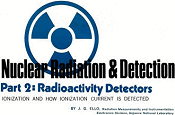 Part 1 of this 3-part series discussed the
basics of nuclear radiation, and now here in Part 2, author Ello delves
into various methods of detecting and measuring radiation levels. Ionizing radiation
measurement capability is needed for the safety of life forms due its ability to
knock electrons away from their host atoms, thus generating ions that cause molecules
to form that might not otherwise do so. If those molecules happen to part of a self-reproducing
living cell, then a mutant - or cancerous - cell is the result. With luck, body
defense cells will hunt down and kill it, but if not, a tumor will develop - maybe
benign, but maybe malignant. Parts 1, 2, and 3 of this series appeared in the October,
November, and December 1972 issues of Popular Electronics, respectively... Part 1 of this 3-part series discussed the
basics of nuclear radiation, and now here in Part 2, author Ello delves
into various methods of detecting and measuring radiation levels. Ionizing radiation
measurement capability is needed for the safety of life forms due its ability to
knock electrons away from their host atoms, thus generating ions that cause molecules
to form that might not otherwise do so. If those molecules happen to part of a self-reproducing
living cell, then a mutant - or cancerous - cell is the result. With luck, body
defense cells will hunt down and kill it, but if not, a tumor will develop - maybe
benign, but maybe malignant. Parts 1, 2, and 3 of this series appeared in the October,
November, and December 1972 issues of Popular Electronics, respectively...
 RIGOL Technologies is expanding its family
of ultra-portable instruments with the introduction of the
DG800 Pro and DG900 Pro Series Function / Arbitrary Waveform Generators, along
with the DM858 Series Digital Multimeters. Like their predecessors - the DHO800
and DHO900 Series High-Resolution Oscilloscopes - these new generators and multimeters
deliver impressive performance and functionality in a compact and light form factor.
DG800 Pro & DG900 Pro Series Generators The DG800 Pro and DG900 Pro Series Function/Arbitrary
Waveform Generators are packed with functionality. Beyond the obvious performance
of function generation and arbitrary waveform generation, these instruments include
the capabilities of noise generator, pulse generator, harmonic generator, analog/digital
modulator, and frequency counter. They deliver impressive performance - up to 200
MHz maximum output frequency, 1.25 GSa/s sample rate, 16-bit vertical resolution,
and 3 ns rise time... RIGOL Technologies is expanding its family
of ultra-portable instruments with the introduction of the
DG800 Pro and DG900 Pro Series Function / Arbitrary Waveform Generators, along
with the DM858 Series Digital Multimeters. Like their predecessors - the DHO800
and DHO900 Series High-Resolution Oscilloscopes - these new generators and multimeters
deliver impressive performance and functionality in a compact and light form factor.
DG800 Pro & DG900 Pro Series Generators The DG800 Pro and DG900 Pro Series Function/Arbitrary
Waveform Generators are packed with functionality. Beyond the obvious performance
of function generation and arbitrary waveform generation, these instruments include
the capabilities of noise generator, pulse generator, harmonic generator, analog/digital
modulator, and frequency counter. They deliver impressive performance - up to 200
MHz maximum output frequency, 1.25 GSa/s sample rate, 16-bit vertical resolution,
and 3 ns rise time...
 TiVO systems are just the latest incarnation
of programmable systems for
recording television programs for playback at a later time. In 1972, Sears,
Roebuck & Company announced "plans to market the first integrated videotape
cartridge recording-playback unit for the home." It was part of a package that included
a specially designed 25" color TV, a camera, and a recording / playback unit. The
projected price of $1,600 is equivalent to $12,006 in 2024 money. As always, it
was the early adopter technophiles who financed the engineering and market research
that eventually led to the sub-$1,000 monster LED TVs and $200 TiVO units of today.
Earned engineering degrees had leveled off in numbers by 1971, with a grand total
of 43,167 Bachelor's degrees, primarily electrical engineering. The American Society
for Engineering Education (ASEE) reports that 106,658 Bachelor degrees in engineering
were awarded in the U.S. in 2015. That represents a 147% increase over 45 years.
The U.S. population has increased by 155% in the same time, so that's about right.
Also in the news was Tandy's takeover of Allied Radio stores, which we know disappeared
many moons ago just as the last vestiges of Radio Shack have pretty much disappeared.
Allied Electronics is now a parts of RS - whatever that is... TiVO systems are just the latest incarnation
of programmable systems for
recording television programs for playback at a later time. In 1972, Sears,
Roebuck & Company announced "plans to market the first integrated videotape
cartridge recording-playback unit for the home." It was part of a package that included
a specially designed 25" color TV, a camera, and a recording / playback unit. The
projected price of $1,600 is equivalent to $12,006 in 2024 money. As always, it
was the early adopter technophiles who financed the engineering and market research
that eventually led to the sub-$1,000 monster LED TVs and $200 TiVO units of today.
Earned engineering degrees had leveled off in numbers by 1971, with a grand total
of 43,167 Bachelor's degrees, primarily electrical engineering. The American Society
for Engineering Education (ASEE) reports that 106,658 Bachelor degrees in engineering
were awarded in the U.S. in 2015. That represents a 147% increase over 45 years.
The U.S. population has increased by 155% in the same time, so that's about right.
Also in the news was Tandy's takeover of Allied Radio stores, which we know disappeared
many moons ago just as the last vestiges of Radio Shack have pretty much disappeared.
Allied Electronics is now a parts of RS - whatever that is...
 With more than 1000
custom-built symbols, this has got to be the most comprehensive set of
Visio Symbols
available for RF, analog, and digital system and schematic drawings! Every object
has been built to fit proportionally on the provided A-, B- and C-size drawing page
templates (or can use your own). Symbols are provided for equipment racks and test
equipment, system block diagrams, conceptual drawings, and schematics. Unlike previous
versions, these are NOT Stencils, but instead are all contained on tabbed pages
within a single Visio document. That puts everything in front of you in its full
glory. Just copy and paste what you need on your drawing... With more than 1000
custom-built symbols, this has got to be the most comprehensive set of
Visio Symbols
available for RF, analog, and digital system and schematic drawings! Every object
has been built to fit proportionally on the provided A-, B- and C-size drawing page
templates (or can use your own). Symbols are provided for equipment racks and test
equipment, system block diagrams, conceptual drawings, and schematics. Unlike previous
versions, these are NOT Stencils, but instead are all contained on tabbed pages
within a single Visio document. That puts everything in front of you in its full
glory. Just copy and paste what you need on your drawing...
Monday the 11th
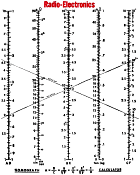 Nobody really needs a printed
nomograph these days given the ready availability of hand-held calculators,
smartphones, and laptop and desktop computers. The upside of other than a nomograph
is that results are more generally more precise with less possibility of error,
and the user does not have to keep track of the decimal point location. The downside
is that there is no visual cue as to how the inputs interact to produce an output.
A nomograph, as presented in this 1967 Radio-Electronics magazine article,
uses points on two indexed scales to intersect a corresponding result on a third
scale. The user can easily see how varying one or both values affects the output.
The nomograph can just as easily be used to calculate a required input or inputs
to arrive at a desired output. For instance, calculating the equivalent resistance
of two resistors connected in parallel, governed by the equation Req
= 1/(1/R1 + 1/R2), is not an easy mental exercise, unlike
with resistors in series, governed by Req = R1 + R2.
Using a nomograph, you locate the value of each resistor on the two respective scales,
then use a straight edge to find where it intersects the resultant resistance scale.
Conversely, if you you need a particular Req and you have an assortments
of resistors from which to make that value... Nobody really needs a printed
nomograph these days given the ready availability of hand-held calculators,
smartphones, and laptop and desktop computers. The upside of other than a nomograph
is that results are more generally more precise with less possibility of error,
and the user does not have to keep track of the decimal point location. The downside
is that there is no visual cue as to how the inputs interact to produce an output.
A nomograph, as presented in this 1967 Radio-Electronics magazine article,
uses points on two indexed scales to intersect a corresponding result on a third
scale. The user can easily see how varying one or both values affects the output.
The nomograph can just as easily be used to calculate a required input or inputs
to arrive at a desired output. For instance, calculating the equivalent resistance
of two resistors connected in parallel, governed by the equation Req
= 1/(1/R1 + 1/R2), is not an easy mental exercise, unlike
with resistors in series, governed by Req = R1 + R2.
Using a nomograph, you locate the value of each resistor on the two respective scales,
then use a straight edge to find where it intersects the resultant resistance scale.
Conversely, if you you need a particular Req and you have an assortments
of resistors from which to make that value...
 When China initiates policies to secure
its social, political, and economic superiority in the world, it is often heralded
as a positive reflection on the patriotic mindset of its people - and it is. However,
when America or EU countries do something similar, it gets reported as the evil
colonialist schemes of White Western cultures. Without doubt, China has many brilliant
scientists, engineers, economists, and doctors who are doing great things, but much
of the root knowledge originated from outside the country. Here's the thanks we
get: "China's push for self-sufficiency targets US tech companies like Dell, IBM,
HP, Cisco Systems, Microsoft, and Oracle. Chinese leader Xi Jinping aims to make
China less dependent on the West and focus on domestic supply chains. Western companies
can tap into opportunities in advanced tech and sales to multinational companies
in China. For American tech companies in China, the writing is reportedly on the
wall or as an exclusive report in Wall Street Journal (WSJ) said, 'its also on paper,
in Document 79.' For those wondering what this Document 79 is, it is a directive
issued by the Chinese government that some refer to as
'Delete A,' for Delete America. Document 79 is said to be so sensitive that
high-ranking officials and executives were only shown the order and weren’t allowed
to make copies. For American tech companies in China, the writing is reportedly
on the wall or as an exclusive report in Wall Street Journal (WSJ) said, 'its also
on paper, in Document 79..." When China initiates policies to secure
its social, political, and economic superiority in the world, it is often heralded
as a positive reflection on the patriotic mindset of its people - and it is. However,
when America or EU countries do something similar, it gets reported as the evil
colonialist schemes of White Western cultures. Without doubt, China has many brilliant
scientists, engineers, economists, and doctors who are doing great things, but much
of the root knowledge originated from outside the country. Here's the thanks we
get: "China's push for self-sufficiency targets US tech companies like Dell, IBM,
HP, Cisco Systems, Microsoft, and Oracle. Chinese leader Xi Jinping aims to make
China less dependent on the West and focus on domestic supply chains. Western companies
can tap into opportunities in advanced tech and sales to multinational companies
in China. For American tech companies in China, the writing is reportedly on the
wall or as an exclusive report in Wall Street Journal (WSJ) said, 'its also on paper,
in Document 79.' For those wondering what this Document 79 is, it is a directive
issued by the Chinese government that some refer to as
'Delete A,' for Delete America. Document 79 is said to be so sensitive that
high-ranking officials and executives were only shown the order and weren’t allowed
to make copies. For American tech companies in China, the writing is reportedly
on the wall or as an exclusive report in Wall Street Journal (WSJ) said, 'its also
on paper, in Document 79..."
 My 1970s-era Radio Shack Micronta model
22-208 FET-VOM with a mirrored scale still does regular duty on my electronics workbench
- particularly when the DMM happens to have been left somewhere else. One of the
first things a person is taught about using analog meters is to always select a
range that put the needle toward the upper end of the scale. It has to do with the
accuracy of the reading based on characteristics of the meter movement. A digital
meters' accuracy is often assumed to be ±1 rightmost displayed digit, but if you
read the specifications, it is often not the case. In this technosaga appearing
in the1972 issue of Popular Electronics magazine, shop-owner Mac informs
his technician, Barney, on many aspects of issues to be aware of when using both
analog and digital meters. Digital meters would never have entered into the discussion
on the earliest stories of "Mac's Radio Service Shop" since they were published
when the only digital displays used Nixie tubes and were too expensive for most
users... My 1970s-era Radio Shack Micronta model
22-208 FET-VOM with a mirrored scale still does regular duty on my electronics workbench
- particularly when the DMM happens to have been left somewhere else. One of the
first things a person is taught about using analog meters is to always select a
range that put the needle toward the upper end of the scale. It has to do with the
accuracy of the reading based on characteristics of the meter movement. A digital
meters' accuracy is often assumed to be ±1 rightmost displayed digit, but if you
read the specifications, it is often not the case. In this technosaga appearing
in the1972 issue of Popular Electronics magazine, shop-owner Mac informs
his technician, Barney, on many aspects of issues to be aware of when using both
analog and digital meters. Digital meters would never have entered into the discussion
on the earliest stories of "Mac's Radio Service Shop" since they were published
when the only digital displays used Nixie tubes and were too expensive for most
users...
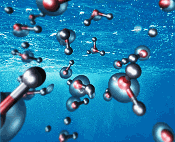 "Researchers at EPFL have achieved a significant
breakthrough in understanding the
electronic properties of water, a fundamental component of life and the environment.
There is no doubt that water is significant. Without it, life would never have begun,
let alone continue today - not to mention its role in the environment itself, with
oceans covering over 70% of Earth. But despite its ubiquity, liquid water features
some electronic intricacies that have long puzzled scientists in chemistry, physics,
and technology. For example, the electron affinity, i.e. the energy stabilization
undergone by a free electron when captured by water, has remained poorly characterized
from an experimental point of view. Even today's most accurate electronic structure
theory has been unable to clarify the picture, which means that important physical
quantities like the energy at which electrons from external sources can be injected
in liquid water remain elusive. These properties are crucial for understanding the
behavior of electrons in water and could play a role in biological systems, environmental
cycles, and technological applications like solar energy conversion..." "Researchers at EPFL have achieved a significant
breakthrough in understanding the
electronic properties of water, a fundamental component of life and the environment.
There is no doubt that water is significant. Without it, life would never have begun,
let alone continue today - not to mention its role in the environment itself, with
oceans covering over 70% of Earth. But despite its ubiquity, liquid water features
some electronic intricacies that have long puzzled scientists in chemistry, physics,
and technology. For example, the electron affinity, i.e. the energy stabilization
undergone by a free electron when captured by water, has remained poorly characterized
from an experimental point of view. Even today's most accurate electronic structure
theory has been unable to clarify the picture, which means that important physical
quantities like the energy at which electrons from external sources can be injected
in liquid water remain elusive. These properties are crucial for understanding the
behavior of electrons in water and could play a role in biological systems, environmental
cycles, and technological applications like solar energy conversion..."
 Ever since the advent of Google Earth in
2001, high resolution photos from orbiting satellites has become routine, expected
technology rather than awe-inspiring technology. In 1970 when this article appeared,
however, satellite imagery was still in its infancy. The
TIROS 1 weather satellite, with a mere 78-day lifespan, had been launched
just a decade earlier. Nations' militaries had the biggest and best platforms, and
pictures like those now routinely seen on Google Earth were highly classified. If
you recall, governments had conniption fits over Google's photos taken of secret
installations. Civilians eventually got space-based images of Earthly weather systems
on the evening news forecast segment, and some commercial users could purchase high
resolution photos from specially licensed private companies. Nowadays, satellites
carry not only optical sensors, but sensors covering a broad span in the electromagnetic
spectrum, gravity sensors, particle detectors and other types of sensors... Ever since the advent of Google Earth in
2001, high resolution photos from orbiting satellites has become routine, expected
technology rather than awe-inspiring technology. In 1970 when this article appeared,
however, satellite imagery was still in its infancy. The
TIROS 1 weather satellite, with a mere 78-day lifespan, had been launched
just a decade earlier. Nations' militaries had the biggest and best platforms, and
pictures like those now routinely seen on Google Earth were highly classified. If
you recall, governments had conniption fits over Google's photos taken of secret
installations. Civilians eventually got space-based images of Earthly weather systems
on the evening news forecast segment, and some commercial users could purchase high
resolution photos from specially licensed private companies. Nowadays, satellites
carry not only optical sensors, but sensors covering a broad span in the electromagnetic
spectrum, gravity sensors, particle detectors and other types of sensors...
 With more than 1000
custom-built stencils, this has got to be the most comprehensive set of
Visio Stencils
available for RF, analog, and digital system and schematic drawings! Every stencil
symbol has been built to fit proportionally on the included A-, B-, and C-size drawing
page templates (or use your own page if preferred). Components are provided for
system block diagrams, conceptual drawings, schematics, test equipment, racks, and
more. Page templates are provided with a preset scale (changeable) for a good presentation
that can incorporate all provided symbols... With more than 1000
custom-built stencils, this has got to be the most comprehensive set of
Visio Stencils
available for RF, analog, and digital system and schematic drawings! Every stencil
symbol has been built to fit proportionally on the included A-, B-, and C-size drawing
page templates (or use your own page if preferred). Components are provided for
system block diagrams, conceptual drawings, schematics, test equipment, racks, and
more. Page templates are provided with a preset scale (changeable) for a good presentation
that can incorporate all provided symbols...
 Anatech Electronics (AEI) manufactures and
supplies RF and microwave
filters for military and commercial communication systems, providing standard
LP, HP, BP, BS, notch, diplexer, and custom RF filters, and RF products. Standard
RF filter and cable assembly products are published in our website database for
ease of procurement. Custom RF filters designs are used when a standard cannot be
found, or the requirements dictate a custom approach for your military and commercial
communications needs. Sam Benzacar's monthly newsletters address contemporary wireless
subjects. Please visit Anatech today to see how they can help your project succeed. Anatech Electronics (AEI) manufactures and
supplies RF and microwave
filters for military and commercial communication systems, providing standard
LP, HP, BP, BS, notch, diplexer, and custom RF filters, and RF products. Standard
RF filter and cable assembly products are published in our website database for
ease of procurement. Custom RF filters designs are used when a standard cannot be
found, or the requirements dictate a custom approach for your military and commercial
communications needs. Sam Benzacar's monthly newsletters address contemporary wireless
subjects. Please visit Anatech today to see how they can help your project succeed.
Friday the 8th
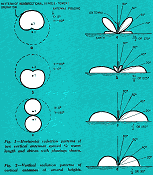 "What's in a name?," as Juliet famously
asked of Romeo's surname, Montague. Here in this 1967 Radio-Electronics
magazine article, author Ray Thrower writes about
phased array antennas. Might not the emission of directed electromagnetic waves
be described as throwing rays? Or, maybe it's just my lame attempt at being profound.
Yeah, probably the latter. Anyway, this is a useful demonstration of how a simple
array of three antennas situated in an "L" pattern and spaced 90° (¼-wave) apart
can be fed with a phase shifting network in order to obtain seven distinct radiation
patterns. That's with using 90° paths in the phase shifter. Other angles would produce
a different set of patterns. Back in the day, patterns were plotted based on equation
solutions worked by hand, using a slide rule. It took a lot of time. Of course some
people can intuitively derive simple patterns without the use of equations. Access
to an electronics computer was available to others, who would encode instructions
in punch cards and feed them into the machine. The resulting table of values had
to be plotted by hand. If you are so motivated, you can model this three-antenna
array into EZNEC... "What's in a name?," as Juliet famously
asked of Romeo's surname, Montague. Here in this 1967 Radio-Electronics
magazine article, author Ray Thrower writes about
phased array antennas. Might not the emission of directed electromagnetic waves
be described as throwing rays? Or, maybe it's just my lame attempt at being profound.
Yeah, probably the latter. Anyway, this is a useful demonstration of how a simple
array of three antennas situated in an "L" pattern and spaced 90° (¼-wave) apart
can be fed with a phase shifting network in order to obtain seven distinct radiation
patterns. That's with using 90° paths in the phase shifter. Other angles would produce
a different set of patterns. Back in the day, patterns were plotted based on equation
solutions worked by hand, using a slide rule. It took a lot of time. Of course some
people can intuitively derive simple patterns without the use of equations. Access
to an electronics computer was available to others, who would encode instructions
in punch cards and feed them into the machine. The resulting table of values had
to be plotted by hand. If you are so motivated, you can model this three-antenna
array into EZNEC...
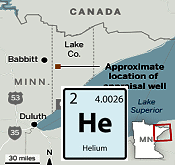 A Canadian mineral exploration firm named
Pulsar announced a gas well finding in Minnesota with initial helium concentration
of 12.4%. They were looking for platinum and palladium. Helium projects are potentially
economically viable when gas extracted from the ground has just 0.3% helium, according
to the article. That follows a nearby 10.5% find in 2011 by U.S. company
Duluth Metals. The
global helium supply has been considered critical for many years as demand increases
for applications as simple as party balloon inflation to cooling for magnetic resonance
imaging (MRI) machines. In January, the
Federal Helium Reserve was sold off to German company
Messer, so the country's
emergency stockpile is gone. Helium (HNT) market prices began 2021 at around $1.30,
peaked at $52 by the end of the year, then gradually returned to around $1.30, and
is ramping up again for today's price of around $9.00. Inn case you don't know,
helium was detected in the
sun's spectral lines before being found on Earth. Its place as element #2 in
the periodic table was empty for many years. A Canadian mineral exploration firm named
Pulsar announced a gas well finding in Minnesota with initial helium concentration
of 12.4%. They were looking for platinum and palladium. Helium projects are potentially
economically viable when gas extracted from the ground has just 0.3% helium, according
to the article. That follows a nearby 10.5% find in 2011 by U.S. company
Duluth Metals. The
global helium supply has been considered critical for many years as demand increases
for applications as simple as party balloon inflation to cooling for magnetic resonance
imaging (MRI) machines. In January, the
Federal Helium Reserve was sold off to German company
Messer, so the country's
emergency stockpile is gone. Helium (HNT) market prices began 2021 at around $1.30,
peaked at $52 by the end of the year, then gradually returned to around $1.30, and
is ramping up again for today's price of around $9.00. Inn case you don't know,
helium was detected in the
sun's spectral lines before being found on Earth. Its place as element #2 in
the periodic table was empty for many years.
 We do not speak of "minicomputers"
today, but if we did, what would come to mind is not an EIA 19" equipment rack packed
full of equipment. Only network servers with teraflops of computing power and/or
petabytes of data storage are configured thus these days. "Minis" in 1972 sported
microprocessors that handled 8- or 16-bit words and a whopping 32 kBytes of operating
system and program execution memory. FORTRAN, ALGOL, and BASIC were the languages
of choice - with no object-oriented code in sight. Don't laugh at the poor slobs
of computer yesteryear or congratulate yourself for living in an enlightened and
highly facilitated time. 45 years from now - heck, 20 years from now - our kids
will look back at 2017 and chuckle at the thought of silicon technology with rigid
binary logic compared to their bioelectronic circuits and quantum computing. Unlike
the the perpetual promise of fusion electricity generators (tokomaks) and a flying
car in every garage, the aforementioned will definitely arrive on schedule - guaranteed
or your subscription fee to RF Cafe will be fully refunded... We do not speak of "minicomputers"
today, but if we did, what would come to mind is not an EIA 19" equipment rack packed
full of equipment. Only network servers with teraflops of computing power and/or
petabytes of data storage are configured thus these days. "Minis" in 1972 sported
microprocessors that handled 8- or 16-bit words and a whopping 32 kBytes of operating
system and program execution memory. FORTRAN, ALGOL, and BASIC were the languages
of choice - with no object-oriented code in sight. Don't laugh at the poor slobs
of computer yesteryear or congratulate yourself for living in an enlightened and
highly facilitated time. 45 years from now - heck, 20 years from now - our kids
will look back at 2017 and chuckle at the thought of silicon technology with rigid
binary logic compared to their bioelectronic circuits and quantum computing. Unlike
the the perpetual promise of fusion electricity generators (tokomaks) and a flying
car in every garage, the aforementioned will definitely arrive on schedule - guaranteed
or your subscription fee to RF Cafe will be fully refunded...
 "Researchers have created a new compound
that can be used to
3D print telecommunication antennas and other connectivity devices. These 3D
printed products, created by combining MXenes with a polymer, can be used as an
alternative for metallic counterparts and can make a vast improvement in communication
technology, including elements such as antennas, waveguides and filters. Waveguides
are everywhere, yet most people don't know what they are, said Dr Mohammad Zarifi,
a researcher in UBC Okanagan's Microelectronics and Gigahertz Applications (OMEGA)
Lab. Dr. Zarifi and his OMEGA team develop communication components that have a
compatible performance to metal, but are 10 to 20 times lighter, less expensive
and easy to build. " "Researchers have created a new compound
that can be used to
3D print telecommunication antennas and other connectivity devices. These 3D
printed products, created by combining MXenes with a polymer, can be used as an
alternative for metallic counterparts and can make a vast improvement in communication
technology, including elements such as antennas, waveguides and filters. Waveguides
are everywhere, yet most people don't know what they are, said Dr Mohammad Zarifi,
a researcher in UBC Okanagan's Microelectronics and Gigahertz Applications (OMEGA)
Lab. Dr. Zarifi and his OMEGA team develop communication components that have a
compatible performance to metal, but are 10 to 20 times lighter, less expensive
and easy to build. "
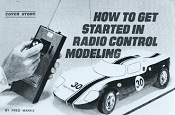 Radio control hobbyists realized a huge
technology advance with the introduction of solid state proportional control systems
that began appearing in the late 1960s. Prior to then, most R/C systems used vacuum
tubes and their accompanying large, heavy batteries. Size and weight was not too
big of a deal for the transmitter, but both those factors for an airborne receiver
significantly impacted airplane design and performance. The new systems enabled
smaller, lighter weight aircraft that not only cost less, but flew better. Of course
other forms of R/C modeling like boats and cars also benefitted from the advances,
but weight and size was not as much of an issue (other than for convenience).
Incremental improvements in electronic components and packaging helped improve solid
state systems through highly integrated circuits for modulation / demodulation function,
servos motor power and efficiency, RF sections, and human interface elements like
gimbal sticks and programmability. An FCC mandate changing the system bandwidth
from 40 MHz to 20 MHz doubled the available unique frequencies (channels)
in the popular 72 MHz (model aircraft only) and 75 MHz (cars & boats
only) unlicensed bands. Ham operators can opt for 50 MHz and 53 MHz operation... Radio control hobbyists realized a huge
technology advance with the introduction of solid state proportional control systems
that began appearing in the late 1960s. Prior to then, most R/C systems used vacuum
tubes and their accompanying large, heavy batteries. Size and weight was not too
big of a deal for the transmitter, but both those factors for an airborne receiver
significantly impacted airplane design and performance. The new systems enabled
smaller, lighter weight aircraft that not only cost less, but flew better. Of course
other forms of R/C modeling like boats and cars also benefitted from the advances,
but weight and size was not as much of an issue (other than for convenience).
Incremental improvements in electronic components and packaging helped improve solid
state systems through highly integrated circuits for modulation / demodulation function,
servos motor power and efficiency, RF sections, and human interface elements like
gimbal sticks and programmability. An FCC mandate changing the system bandwidth
from 40 MHz to 20 MHz doubled the available unique frequencies (channels)
in the popular 72 MHz (model aircraft only) and 75 MHz (cars & boats
only) unlicensed bands. Ham operators can opt for 50 MHz and 53 MHz operation...
 With more than 1000
custom-built stencils, this has got to be the most comprehensive set of
Visio Stencils
available for RF, analog, and digital system and schematic drawings! Every stencil
symbol has been built to fit proportionally on the included A-, B-, and C-size drawing
page templates (or use your own page if preferred). Components are provided for
system block diagrams, conceptual drawings, schematics, test equipment, racks, and
more. Page templates are provided with a preset scale (changeable) for a good presentation
that can incorporate all provided symbols... With more than 1000
custom-built stencils, this has got to be the most comprehensive set of
Visio Stencils
available for RF, analog, and digital system and schematic drawings! Every stencil
symbol has been built to fit proportionally on the included A-, B-, and C-size drawing
page templates (or use your own page if preferred). Components are provided for
system block diagrams, conceptual drawings, schematics, test equipment, racks, and
more. Page templates are provided with a preset scale (changeable) for a good presentation
that can incorporate all provided symbols...
 KR Electronics has been designing and manufacturing custom filters
for military and commercial radio, radar, medical, and communications since 1973.
KR Electronics' line of filters
includes lowpass, highpass, bandpass, bandstop, equalizer, duplexer, diplexer, and
individually synthesized filters for special applications - both commercial and
military. State of the art computer synthesis, analysis and test methods are used
to meet the most challenging specifications. All common connector types and package
form factors are available. Please visit their website today to see how they might
be of assistance. Products are designed and manufactured in the USA. KR Electronics has been designing and manufacturing custom filters
for military and commercial radio, radar, medical, and communications since 1973.
KR Electronics' line of filters
includes lowpass, highpass, bandpass, bandstop, equalizer, duplexer, diplexer, and
individually synthesized filters for special applications - both commercial and
military. State of the art computer synthesis, analysis and test methods are used
to meet the most challenging specifications. All common connector types and package
form factors are available. Please visit their website today to see how they might
be of assistance. Products are designed and manufactured in the USA.
These archive pages are provided in order to make it easier for you to find items
that you remember seeing on the RF Cafe homepage. Of course probably the easiest
way to find anything on the website is to use the "Search
RF Cafe" box at the top of every page.
About RF Cafe.
Homepage Archive Pages
2024:
Jan |
Feb |
Mar |
Apr |
May |
Jun |
Jul |
Aug |
Sep |
Oct |
Nov |
Dec
2023:
Jan |
Feb |
Mar |
Apr |
May |
Jun |
Jul |
Aug |
Sep |
Oct |
Nov |
Dec
2022:
Jan |
Feb |
Mar |
Apr |
May |
Jun |
Jul |
Aug |
Sep |
Oct |
Nov |
Dec
2021:
Jan |
Feb |
Mar |
Apr |
May |
Jun |
Jul |
Aug |
Sep |
Oct |
Nov |
Dec
2020:
Jan |
Feb |
Mar |
Apr |
May |
Jun |
Jul |
Aug |
Sep |
Oct |
Nov |
Dec
2019:
Jan |
Feb |
Mar |
Apr |
May |
Jun |
Jul |
Aug |
Sep |
Oct |
Nov |
Dec
2018:
Jan |
Feb |
Mar |
Apr |
May |
Jun |
Jul |
Aug |
Sep |
Oct |
Nov |
Dec
2017:
Jan |
Feb |
Mar |
Apr |
May |
Jun |
Jul |
Aug |
Sep |
Oct |
Nov |
Dec
2016:
Jan |
Feb |
Mar |
Apr |
May |
Jun |
Jul |
Aug |
Sep |
Oct |
Nov |
Dec
2015:
Jan |
Feb |
Mar |
Apr |
May |
Jun |
Jul |
Aug |
Sep |
Oct |
Nov |
Dec
2014:
Jan |
Feb |
Mar |
Apr |
May |
Jun |
Jul |
Aug |
Sep |
Oct |
Nov |
Dec
2013:
Jan |
Feb |
Mar |
Apr |
May |
Jun |
Jul |
Aug |
Sep |
Oct |
Nov |
Dec
2012:
1 |
2 |
3 |
4 |
5 |
6 |
7 |
8 |
9 |
10 |
11 |
12 |
13 (no archives before 2012)
|






















































 Radio control hobbyists
Radio control hobbyists
